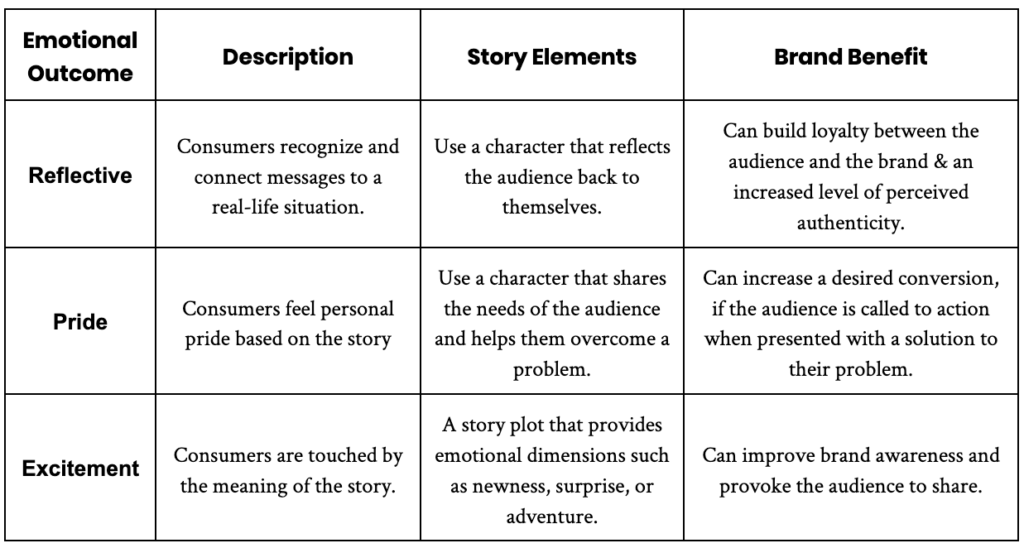Storytelling drives engagement. But are all stories created equal? That’s a different story.
If audiences trust your brand to take them on a journey, then you better know where you’re taking them.Revmade regularly scours the internet for new studies that offer important insights for marketers. Then we write them up for you in as few words as possible. (Want to get them emailed to you? Sign up here.)
People love good stories. A good story has the power to rally communities, call advocates to action, and transport people to different worlds. And of course, brands have discovered they can harness the power of storytelling to better engage customers. But as we’ve heard, “with power comes great responsibility.” If an audience trusts your brand to take them on a journey, you owe it to them to have a good destination in mind.
Luckily, we found this study that not only explores how stories generate consumer engagement for brands, but also tees up ideas for emotional outcomes that brands can consider when creating stories for audiences.
Why should I care? You’re probably already planning your channel strategy through the context of both your audience’s needs and your brand’s goals. And your storytelling efforts should follow this same framework. If you develop a story without a desired audience outcome you might fall flat in your engagement efforts, and you don’t want to miss out on the valuable benefits of storytelling such as:
- An increased sense of authenticity. When a brand shares a story told by real people, it gives the audience people to identify with, leading to a higher perceived level of authenticity. This is a major motivation for an audience to engage with a brand, leading to higher levels of trust and loyalty.
- Improved levels of brand awareness. We’ve all been engrossed in an engaging tale before. That’s because stories affect an audience’s listening behavior. Research indicates that storytelling facilitates information processing and captures attention better than other means. Audiences have higher levels of recall and can help fill in missing gaps of information. This is especially important for helping audiences remember your brand.
- More organic sharing by the audience. Storytelling, especially personal experiences, activates emotional and cognitive responses in the brain. This can lead an audience to be more willing to share information or take a desired action.
For example, the researchers in the study documented several emotional states your audience could be led to through storytelling:

Not all stories are created equal – and though transformative, not all storytelling techniques will lead audiences to the same emotional end state.
What do I do now?
- Know where you have permission to take your audience. Your audience trusts your brand, so don’t end a story in an emotional place they didn’t expect to go. If your brand is all about being inspirational, don’t leave your audience with a depressing ending that leaves them in a state of sadness and hopelessness. After all, if you got on a plane expecting to go to the Bahamas but somehow ended up in Siberia – you’d be pretty bummed out.
- Plan with the end in mind. Determine how you want your audience to feel at the end of a story. Perhaps you want them to be in a state of reflection, confidence, or excitement. Once the destination is determined, the plot and characters can be used to transport the audience to a different state of mind — and hopefully it’s the one your brand intended to take them to!
- Utilize story elements that reflect the audience. Use story elements such as identifiable characters and a plot that develops those characters. The audience should recognize themselves in the character and they should feel inspired to take action in order to achieve the goal presented.
- Call your audience to action. At the end of your story, the audience should feel the way you want them to feel. At that point, enable your audience to act. Whatever your desired action is for them, make sure it’s explicit — whether that means signing up for a newsletter, sharing the story, completing a transaction, or something else entirely.
TL;DR: You wouldn’t create a strategy without the end goal in mind – the same applies to storytelling. Start with the end in mind – as the author you’re responsible for taking your audience on a journey, and they deserve a good destination.
Subscribe
Get our weekly newsletter for tips on how to drive better content marketing performance.
For a regular stream of ideas, research and links we find helpful. And of course, to say hi!
